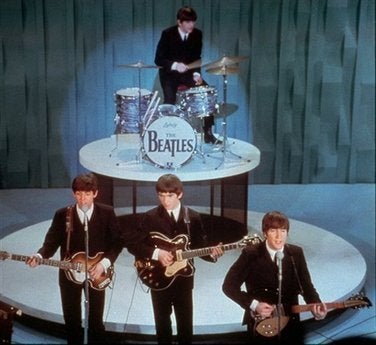
Two female icons from the 1960's passed away last week, Lucy O'Donnell Vodden and Susan Atkins. These two women didn't know about one another, and the only common thread they share is that their stories intersect with that of the Beatles. This is where their similarities end. The rest is pure contrast. The former lived in Britain and the latter in California. One would help to inspire the Beatles' music; the other would help to pervert it. One would remain an enigma whose legend mystified millions, while the other became a high profile murderer who horrified millions more.
In 1966, Lucy O'Donnell was attending the Heath House Infants School in the London suburb of Weybridge. One of her classmates was a very young Julian Lennon. It is not known exactly what attracted Julian to Lucy, but it was clear, as Julian himself admits, that he carried an affection for her at the tender age of three-and-a-half years. This would inspire Julian to make a watercolor painting of his friend, which he took home and showed to his father, John Lennon. Although clearly an advanced piece of work for a three-year-old, the piece was typical of young children, who don't yet grasp the concept of gravity and tend to draw their subjects floating in air. This subject in particular had diamond-shaped eyes, and Julian described her to his father as "Lucy in the sky." As soon as the phrase reached John's ears, the song practically wrote itself, and Lucy in the Sky with Diamonds was treated with an elaborate production style that would make it a standout track on the following summer's smash album, Sgt. Pepper's Lonely Hearts Club Band. Unfortunately, the song would be banned by the BBC, and by several American radio stations, because it was widely assumed to be a blatant reference to LSD, a drug that was blamed for influencing and empowering a subversive counterculture. It wasn't true, and it was not the last time that an innocent Beatles lyric would be woefully misinterpreted.
While Sgt. Pepper dominated the charts in the summer of 1967, Susan Atkins was living in San Francisco -- a high school dropout with an arrest record who worked odd jobs, including strip dancing, to stay afloat. Left homeless after police raided her crash pad, she was invited by her friend Charlie Manson to go on the road with him and his group of idyllic followers. Charlie had only recently been released from prison and had in fact spent over half his life in correctional institutions. He created an alias for Ms. Atkins: Sadie Mae Glutz. By the following summer, Charlie and his followers were living at the Spahn Movie Ranch in the Santa Susana Mountains, about forty minutes outside of Los Angeles. Initially, for Atkins, life at the ranch was mostly about songs, drugs and group sex (which led to a child she would later give up). Then, in 1969, Charlie heard The Beatles (aka The White Album) and everything changed. He believed that the album's lyrics were a transatlantic message aimed directly at him, which, combined with certain Bible verses, outlined a blueprint for an Armageddon from which he would deliver all mankind. All he needed were willing participants who would follow his orders and ignite it for him, and Sadie was among those willing to oblige. Almost overnight, peace and love gave way to auto theft, armed robbery and murder, and by the end of the summer of '69, nine people in and around Los Angeles were brutally slain.
The indictment and trial of Manson, Atkins and their accomplices was a media feeding frenzy that set the standard for all sensationalized cases that have come since. And the defendants ate up every second of the attention. After two years of sociopathic dogma from Charlie, Sadie and her cohorts were ready to spew it all back to the court and the cameras. They let themselves become America's bogeymen, compounding the horror and fear that had already gripped the nation by achieving a sick level of cult hero status.
Back in England, Lucy would seek none of the publicity that surely would have come her way for being the subject of one of the most famous rock songs of all time. The small handful of friends she bothered to tell didn't buy it, choosing instead to embrace the LSD myth. Embarrassed at not really knowing what the acid thing was all about, she kept her mouth shut and lived a normal, anonymous life. She had no misconceptions about who she was -- not some walking muse at age three, just a childhood friend of a boy that happened to be the son of a legend. And there she remained, thoroughly grounded in reality and humility until her death. Her last years were made more bearable by the reappearance of her old classmate Julian, who reached out regularly to her with gifts and moral support.
But Susan never really found herself. Having embraced Christian fundamentalism -- and two marriages -- in order to break free from Manson's grip, Atkins spent her life as a follower. Her life ended with bitter rejection and scorn. Therein lies the tragedy. The Beatles, through words and deeds, presented a generation of young souls with a simple challenge: To find their authentic selves, discover their potential, cultivate love, and live in peace. Lucy succeeded where Sadie failed.